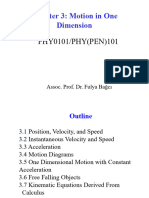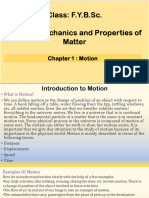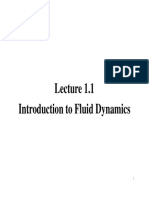0 ratings0% found this document useful (0 votes)
HEC Waheed Physics I Session 1
Uploaded by
Gaming LegendsThis document provides a summary of the Physics I course offered on Wednesdays from 12:30-2:00 pm. The course is taught by Waheeduddin Hyder in the Department of Computer Science. The first lecture covers key concepts like displacement, velocity, acceleration, and sound wave intensity. Definitions and formulas are presented for these terms along with examples and explanations. Reference materials are listed at the end.
Copyright:
© All Rights Reserved
Available Formats
Download as PDF, TXT or read online from Scribd
Download as pdf or txt
HEC Waheed Physics I Session 1
Uploaded by
Gaming Legends0 ratings0% found this document useful (0 votes)
This document provides a summary of the Physics I course offered on Wednesdays from 12:30-2:00 pm. The course is taught by Waheeduddin Hyder in the Department of Computer Science. The first lecture covers key concepts like displacement, velocity, acceleration, and sound wave intensity. Definitions and formulas are presented for these terms along with examples and explanations. Reference materials are listed at the end.
Copyright
© © All Rights Reserved
Available Formats
PDF, TXT or read online from Scribd
Share this document
Did you find this document useful?
Is this content inappropriate?
This document provides a summary of the Physics I course offered on Wednesdays from 12:30-2:00 pm. The course is taught by Waheeduddin Hyder in the Department of Computer Science. The first lecture covers key concepts like displacement, velocity, acceleration, and sound wave intensity. Definitions and formulas are presented for these terms along with examples and explanations. Reference materials are listed at the end.
Copyright:
© All Rights Reserved
Available Formats
Download as PDF, TXT or read online from Scribd
Download as pdf or txt
0 ratings0% found this document useful (0 votes)
HEC Waheed Physics I Session 1
Uploaded by
Gaming LegendsThis document provides a summary of the Physics I course offered on Wednesdays from 12:30-2:00 pm. The course is taught by Waheeduddin Hyder in the Department of Computer Science. The first lecture covers key concepts like displacement, velocity, acceleration, and sound wave intensity. Definitions and formulas are presented for these terms along with examples and explanations. Reference materials are listed at the end.
Copyright:
© All Rights Reserved
Available Formats
Download as PDF, TXT or read online from Scribd
Download as pdf or txt
You are on page 1/ 19
Course Code: AS111
Course Title: PHYSICS I
Class Day: WED Timing: 12:30 – 2:00
Lecture / Week No. 1
Instructor Name: Waheeduddin Hyder
Department of Computer Science
Contents
1. Displacement
2. Velocity
3. Acceleration
4. Sound Wave Intensity
Reference No 1 Displacement
Reference No 1
Reference No 1
• If a particle is moving, we can easily determine its change in position.
The displacement of a particle is defined as its change in position.
• As it moves from an initial position xi to a final position xf, its
displacement is given by xf - xi
• We use the Greek letter delta (∆) to denote the change in a quantity.
• Therefore, we write the displacement, or change in position, of the
particle as
Reference No 1
• Displacement is an example of a vector quantity.
• Many other physical quantities, including velocity and acceleration,
also are vectors.
• In general, a vector is a physical quantity that requires the
specification of both direction and magnitude.
• By contrast, a scalar is a quantity that has magnitude and no
direction.
• In this chapter, we use plus and minus signs to indicate vector
direction.
Reference No 1
Reference No 1
Reference No 1
• We can do this because the chapter deals with one-dimensional
motion only; this
means that any object we study can be moving only along a straight
line.
• For example, for horizontal motion, let us arbitrarily specify to the
right as being the positive direction.
• It follows that any object always moving to the right undergoes a
positive displacement , and any object moving to the left undergoes a
negative displacement x.
Reference No 1
Reference No 1 Velocity
• The average velocity ‘v’ of a particle is defined as the particle’s
displacement ∆x divided by the time interval ∆t during which that
displacement occurred:
Reference No 1 Speed
• In everyday usage, the terms speed and velocity are interchangeable.
• In physics, however, there is a clear distinction between these two
quantities.
• Consider a marathon runner who runs more than 40 km, yet ends up at his
starting point.
• His average velocity is zero! Nonetheless, we need to be able to quantify
how fast he was running.
• The average speed of a particle, a scalar quantity, is defined as the total
distance traveled divided by the total time it takes to travel that distance:
Avg Speed = Total Distance/Total Time
Reference No 1 Instantaneous Velocity & Speed
• The instantaneous velocity vx equals the limiting value of the ratio ∆x/ ∆ t
as ∆ t approaches zero
• The instantaneous speed of a particle is defined as the magnitude of its
velocity.
Reference No 1
Reference No 1
Reference No 1 Acceleration
• The average acceleration of the particle is defined as the change in
velocity ∆vx divided by the time interval ∆t during which that change
occurred:
Reference No 1
Reference No 1
References / Resources
• 1 - University Physics, Sears and Zemansky, Pearson Education
• 2 -https://en.wikipedia.org/wiki/Wave_interference#/media/File:Interference_of_two_waves.svg
• 3 - https://www.britannica.com/science/light/Youngs-double-slit-experiment
You might also like
- Lecture 1 and 2: Saif Ahmed (Sfa) Lecturer, Department of Mathematics and Physics North South UniversityNo ratings yetLecture 1 and 2: Saif Ahmed (Sfa) Lecturer, Department of Mathematics and Physics North South University26 pages
- Chapter 2 Motion in One Dimension - 2024 NotesNo ratings yetChapter 2 Motion in One Dimension - 2024 Notes15 pages
- Waves Class 11 Notes Physics Chapter 15 - Learn CBSENo ratings yetWaves Class 11 Notes Physics Chapter 15 - Learn CBSE9 pages
- UNIT 1 Chaptar 1 MOVEMENT AND POSITION (Repaired)No ratings yetUNIT 1 Chaptar 1 MOVEMENT AND POSITION (Repaired)52 pages
- Transverse Waves and Longitudinal WavesNo ratings yetTransverse Waves and Longitudinal Waves11 pages
- Aakash 02 - Description of Motion in One DimensionNo ratings yetAakash 02 - Description of Motion in One Dimension8 pages
- Motion in A Straight Line Notes CLASS 11No ratings yetMotion in A Straight Line Notes CLASS 116 pages
- 2 Description of Motion in One DimensionNo ratings yet2 Description of Motion in One Dimension11 pages
- Motion in A Straight Line: by Shahzada Khan (M.SC in Physics)100% (1)Motion in A Straight Line: by Shahzada Khan (M.SC in Physics)15 pages
- Gurukul Oswal Ojective Physics AIIMS IITJEE 2-48-80No ratings yetGurukul Oswal Ojective Physics AIIMS IITJEE 2-48-8033 pages
- IGCSE Math 0580 Similarity Volume and Area Past Papers Worksheet P2No ratings yetIGCSE Math 0580 Similarity Volume and Area Past Papers Worksheet P29 pages
- Construction Regulations Presentation 26082023 Ver1.1No ratings yetConstruction Regulations Presentation 26082023 Ver1.121 pages
- ClimaCheck Emailable Brochure Folder - Eng - 110627 - medBE - VerticalNo ratings yetClimaCheck Emailable Brochure Folder - Eng - 110627 - medBE - Vertical6 pages
- Metals: Charpy Impact Properties of Hydrogen-Exposed 316L Stainless Steel at Ambient and Cryogenic TemperaturesNo ratings yetMetals: Charpy Impact Properties of Hydrogen-Exposed 316L Stainless Steel at Ambient and Cryogenic Temperatures14 pages
- Green Supply Chain Management in Leading Manufacturers: Case Studies in Japanese Large CompaniesNo ratings yetGreen Supply Chain Management in Leading Manufacturers: Case Studies in Japanese Large Companies14 pages
- Beginners Guide To Hypnosis (Your Questions Answered) - Cal Banyan100% (2)Beginners Guide To Hypnosis (Your Questions Answered) - Cal Banyan12 pages
- Chemistry For Engineers 1 Energy Topic 04 Nuclear Chemistry 1No ratings yetChemistry For Engineers 1 Energy Topic 04 Nuclear Chemistry 16 pages
- 2025 New IB Chemistry R1.1 Measuring enthalpy changesNo ratings yet2025 New IB Chemistry R1.1 Measuring enthalpy changes28 pages
- Brown, S. L. and Eisenhardt, K. M. (1997)No ratings yetBrown, S. L. and Eisenhardt, K. M. (1997)34 pages
- A Gamers Guide To Building A Gaming Computer - David Talmage100% (2)A Gamers Guide To Building A Gaming Computer - David Talmage130 pages
- The Pre-Natufian Epipaleolithic: Long-Term Behavioral Trends in The LevantNo ratings yetThe Pre-Natufian Epipaleolithic: Long-Term Behavioral Trends in The Levant14 pages
- Daily Drilling Fluid Report A4 Size (030A) - EnglishNo ratings yetDaily Drilling Fluid Report A4 Size (030A) - English1 page
- Therm Runaway Test 18650 Li-Ion ClobatoNo ratings yetTherm Runaway Test 18650 Li-Ion Clobato43 pages
- Lecture 1 and 2: Saif Ahmed (Sfa) Lecturer, Department of Mathematics and Physics North South UniversityLecture 1 and 2: Saif Ahmed (Sfa) Lecturer, Department of Mathematics and Physics North South University
- Waves Class 11 Notes Physics Chapter 15 - Learn CBSEWaves Class 11 Notes Physics Chapter 15 - Learn CBSE
- Aakash 02 - Description of Motion in One DimensionAakash 02 - Description of Motion in One Dimension
- Motion in A Straight Line: by Shahzada Khan (M.SC in Physics)Motion in A Straight Line: by Shahzada Khan (M.SC in Physics)
- Gurukul Oswal Ojective Physics AIIMS IITJEE 2-48-80Gurukul Oswal Ojective Physics AIIMS IITJEE 2-48-80
- IGCSE Math 0580 Similarity Volume and Area Past Papers Worksheet P2IGCSE Math 0580 Similarity Volume and Area Past Papers Worksheet P2
- Construction Regulations Presentation 26082023 Ver1.1Construction Regulations Presentation 26082023 Ver1.1
- ClimaCheck Emailable Brochure Folder - Eng - 110627 - medBE - VerticalClimaCheck Emailable Brochure Folder - Eng - 110627 - medBE - Vertical
- Metals: Charpy Impact Properties of Hydrogen-Exposed 316L Stainless Steel at Ambient and Cryogenic TemperaturesMetals: Charpy Impact Properties of Hydrogen-Exposed 316L Stainless Steel at Ambient and Cryogenic Temperatures
- Green Supply Chain Management in Leading Manufacturers: Case Studies in Japanese Large CompaniesGreen Supply Chain Management in Leading Manufacturers: Case Studies in Japanese Large Companies
- Beginners Guide To Hypnosis (Your Questions Answered) - Cal BanyanBeginners Guide To Hypnosis (Your Questions Answered) - Cal Banyan
- Chemistry For Engineers 1 Energy Topic 04 Nuclear Chemistry 1Chemistry For Engineers 1 Energy Topic 04 Nuclear Chemistry 1
- 2025 New IB Chemistry R1.1 Measuring enthalpy changes2025 New IB Chemistry R1.1 Measuring enthalpy changes
- A Gamers Guide To Building A Gaming Computer - David TalmageA Gamers Guide To Building A Gaming Computer - David Talmage
- The Pre-Natufian Epipaleolithic: Long-Term Behavioral Trends in The LevantThe Pre-Natufian Epipaleolithic: Long-Term Behavioral Trends in The Levant
- Daily Drilling Fluid Report A4 Size (030A) - EnglishDaily Drilling Fluid Report A4 Size (030A) - English

























































































